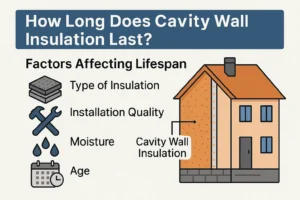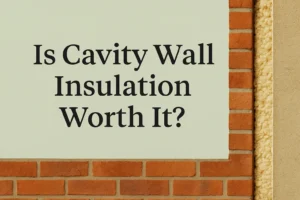If you own a home in the UK, chances are you’ve heard about cavity wall insulation — and for good reason. It’s one of the most effective ways to improve your home’s energy efficiency, reduce heat loss, and cut your energy bills. But if your property was insulated years ago, or you’re considering installing it for the first time, you might be wondering: how long does cavity wall insulation actually last?
Table of Contents
ToggleThe short answer is: it can last anywhere from 20 to 100 years, depending on a range of factors from the materials used to how well it was installed and maintained. In many cases, cavity wall insulation can last the entire lifespan of your property, especially if installed by qualified professionals.
In this guide, we’ll explore how long cavity wall insulation typically lasts, what affects its longevity, how to spot signs of deterioration, and what you can do to keep it performing effectively for years to come. We’ll also cover when it may need replacing and how you can access government grants to get it done for free.
1. Typical Lifespan of Cavity Wall Insulation in the UK
Cavity wall insulation is designed to be a long-term solution. In most cases, it can last at least 25 years, with many materials remaining effective for up to 100 years when installed correctly and kept in good condition.
Many professional installers including those approved under the ECO4 scheme provide a 25-year guarantee, giving homeowners peace of mind. But the actual performance and longevity often go beyond this, especially if:
- High-quality materials like polystyrene beads or fibreglass were used.
- The installation was completed by a trained professional.
- The cavity walls are protected from moisture ingress, pest damage, and extreme temperature swings.
Can It Last a Lifetime?
Yes, in many cases, cavity wall insulation can last for the entire lifespan of the property, particularly if the walls remain dry and structurally sound. However, homes that suffer from issues such as damp, poorly maintained brickwork, or extreme weather conditions may require earlier inspection or even insulation renewal.
Regular checks by a qualified surveyor can ensure your insulation is still doing its job and help spot problems before they become costly.
Check If You Qualify For FREE Cavity Wall Insulation
2. Lifespan by Insulation Type
Not all cavity wall insulation materials are created equal — their durability and performance over time can vary significantly. The material used during installation is one of the biggest factors influencing how long your insulation will last.
Below is a breakdown of the most common insulation materials used in UK homes and their estimated lifespan:
| Insulation Material | Estimated Lifespan | Key Features |
|---|---|---|
| Polystyrene Beads (EPS) | Up to 100 years | Excellent moisture resistance, long-lasting, does not settle |
| Fibreglass Insulation | 80 – 100 years | Resistant to mould and decay, retains performance long-term |
| Mineral Wool | Around 50 years | Affordable and fire-resistant, but can settle over time |
| Polyurethane Foam (PU Foam) | More than 50 years | High thermal performance, good for hard-to-reach cavities |
| Extruded Polystyrene (XPS) | Around 20 – 30 years | Lightweight and water-resistant, but less durable than EPS |
Choosing the Right Material
When choosing cavity wall insulation, it’s not just about upfront cost it’s about performance over time. For example:
- EPS beads are ideal for longevity and moisture control.
- Mineral wool is cost-effective but may settle or degrade if exposed to damp.
- Spray foam creates a tight seal but is more expensive and harder to remove if needed.
If your home was insulated over two decades ago, it’s worth checking what material was used and whether it’s still performing as intended.
3. Key Factors That Influence Cavity Wall Insulation Lifespan
While many insulation materials are built to last, their actual lifespan depends heavily on how they’re installed, maintained, and protected. Below are the main factors that determine how long your cavity wall insulation will remain effective.
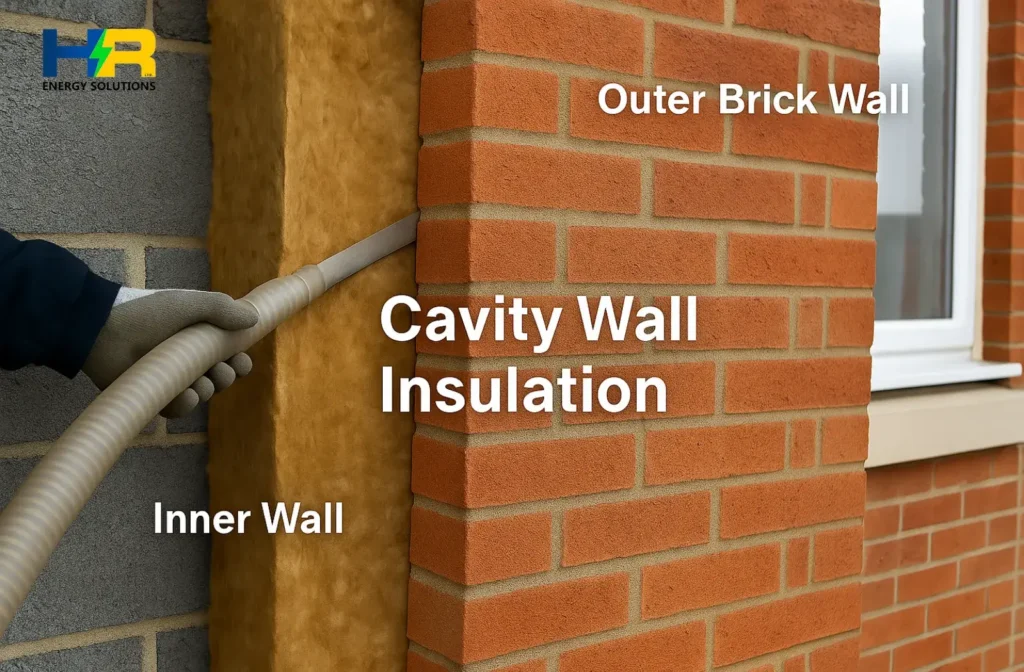
1. Installation Quality
The biggest influence on how long cavity wall insulation lasts is how well it was installed. Poor installation can leave gaps or cold bridges that reduce performance and accelerate wear. That’s why using a certified installer under schemes like ECO4 is essential it ensures proper coverage and long-term durability.
2. Material Type
Different materials have different strengths:
- EPS beads resist moisture and last the longest.
- Mineral wool is cost-effective but may slump or settle over time.
- Spray foam offers airtightness but is harder to remove later.
Choosing the right material for your wall type, climate, and budget plays a major role in insulation longevity.
Looking at other insulation options? See how solid wall insulation compares in lifespan and performance.
3. Moisture Exposure
Moisture is the number one enemy of insulation. If rainwater penetrates cracked or unsealed walls, it can soak the insulation, causing it to clump, sag, or grow mould. This is especially a risk with older mineral wool installations. Regular wall maintenance and repointing are vital to keeping moisture out.
4. Wall Condition
Cracks in the brickwork or poor ventilation in the cavity can reduce insulation effectiveness. Structural issues or shifting foundations may also create voids or compress insulation over time.
5. Pest Infestation
Rodents or insects can nest in insulation, damaging it by burrowing or chewing. This is more common in rural properties or homes with gaps in the wall structure. Addressing pest entry points helps protect your insulation layer.
6. Temperature Extremes
Frequent freeze-thaw cycles, especially in parts of Scotland or northern England, can cause minor expansion and contraction in wall materials. Over time, this can lead to micro-movement or cracks, affecting both insulation and wall integrity.
7. DIY vs Professional Installation
While DIY insulation kits exist, they often lack the precision and quality assurance of professional jobs. DIY jobs may leave voids, uneven distribution, or cause hidden structural issues — all of which drastically shorten insulation lifespan.
Taking a whole-house approach to insulation including regular inspections and working with trusted professionals is the best way to ensure your cavity wall insulation performs well for decades.
4. Signs That Your Cavity Wall Insulation May Be Failing
Even high-quality cavity wall insulation can deteriorate over time — especially if it was poorly installed or has been exposed to moisture or damage. Spotting the early warning signs can help you take timely action before your home becomes less energy efficient or develops issues like damp or mould.
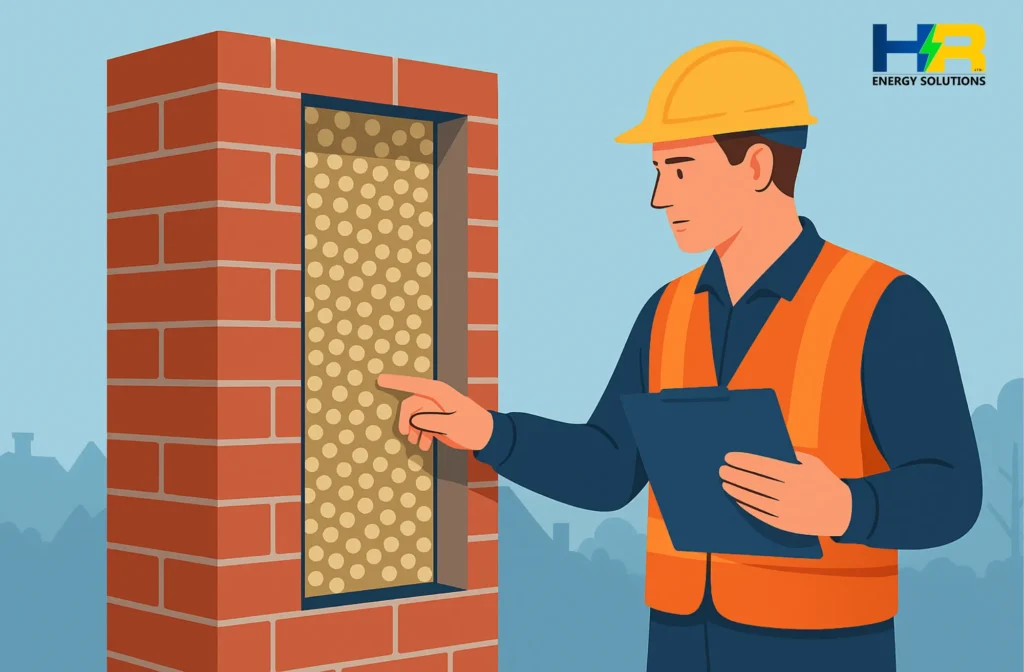
Here are the most common signs that your cavity wall insulation may no longer be performing effectively:
1. Cold Spots or Drafts Indoors
If you’re feeling uneven temperatures, especially near exterior walls, or noticing persistent cold spots despite heating your home, it could indicate that insulation has settled, become patchy, or was never installed correctly.
2. Rising Energy Bills
Sudden or gradual increases in your heating costs could point to insulation that’s no longer preventing heat loss effectively. If your energy usage hasn’t changed but your bills have gone up, the insulation might be underperforming.
3. Damp Patches or Mould on Internal Walls
Visible signs of moisture, such as black mould, flaking paint, or damp smells on inside walls, may suggest that water has entered the cavity and saturated the insulation. This is especially concerning with older mineral wool or poorly protected installations.
4. Cracks or Damage to External Walls
Cracks in brickwork, degraded pointing, or broken render can let rainwater into the cavity, directly impacting insulation. Even small gaps can lead to serious insulation problems over time.
5. Your Insulation is Over 25 Years Old
If your cavity wall insulation was installed more than 25 years ago, especially before modern materials and methods became standard, it might be time for a professional check — even if there are no obvious problems.
6. Musty Odours or Wall Discolouration
Persistent musty smells or yellowing patches on internal walls may indicate trapped moisture or decaying insulation behind the scenes. These subtle clues are often the first sign something is wrong.
If you’ve noticed one or more of these signs, it’s worth booking an insulation inspection. At HnR Energy Solutions, we can carry out a free assessment to check whether your cavity wall insulation is still performing or if it’s time for a refresh under government-funded schemes like ECO4 or GBIS.
5. Can Cavity Wall Insulation Be Renewed or Replaced?
Yes, while cavity wall insulation is designed to last decades, there are times when it may need to be renewed, topped up, or completely removed and replaced. The good news? In many cases, this can be done quickly, and it may even be fully funded under government schemes like ECO4 or the Great British Insulation Scheme (GBIS).
When Might Renewal or Replacement Be Necessary?
You may need to renew or replace your cavity wall insulation if:
- The insulation has been damaged by moisture or flooding.
- It was installed using outdated or unsuitable materials.
- There are gaps, cold spots, or signs of settlement within the cavity.
- Pests or rodents have compromised the material.
- The installation was not carried out to modern standards.
- You’ve had structural repairs or extensions that exposed the cavity.
How Does Removal and Replacement Work?
If your insulation has failed, specialists can safely extract it using a process that combines compressed air and vacuum extraction. This removes insulation beads, mineral wool, or foam from the cavity.
Once cleared, the walls can be reinsulated with modern materials like EPS beads, which are moisture-resistant and designed to last up to 100 years.
How to Check if Renewal is Needed
A professional insulation installer or assessor may use tools such as:
- Borescope inspection – a small camera inserted into the wall cavity.
- Thermal imaging – identifies heat loss and cold spots.
- Moisture meters – to check for trapped damp within wall cavities.
These methods are quick, non-invasive, and often free when booked through approved providers like HNR Energy Solutions.
Don’t Guess – Get It Checked
If you’re unsure about the condition of your insulation, it’s always better to get it professionally assessed. Left unchecked, poor or degraded insulation can lead to long-term issues with heat loss, damp, and indoor air quality.
6. How to Prolong the Life of Your Cavity Wall Insulation
Cavity wall insulation can last for decades but only if it’s properly installed and maintained. Whether your insulation is brand new or has been in place for years, taking a few simple steps can help it perform efficiently for as long as possible.
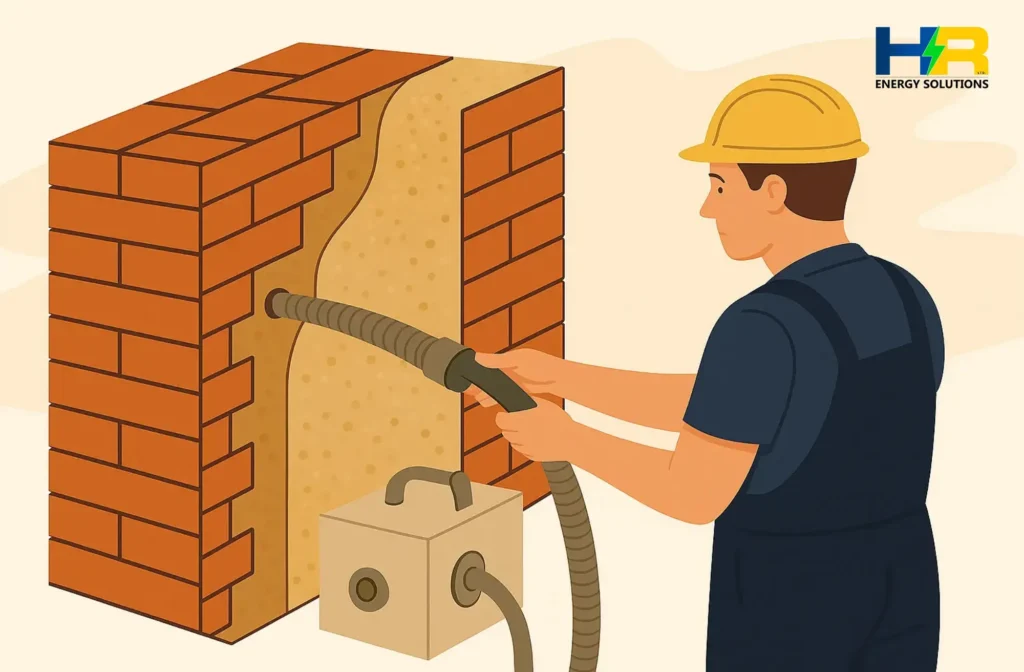
1. Keep External Walls in Good Condition
Inspect your brickwork, render, or pointing regularly. Cracks, gaps, or loose bricks can allow rainwater to seep into the cavity, damaging your insulation. Timely repointing and repairs help keep moisture out and performance high.
2. Ensure Proper Ventilation
Lack of ventilation can lead to condensation buildup inside the cavity, which encourages dampness and mould. Ensure your home has adequate background ventilation, especially in kitchens and bathrooms. Passive vents or extractor fans can help.
3. Schedule Professional Inspections
A thermal imaging scan or borescope check by a qualified installer every few years can identify potential issues before they worsen. Early detection of gaps, settlement, or damp can save you thousands in future repairs.
4. Seal Entry Points Against Pests
Rodents and insects can damage insulation by nesting inside walls. Seal external gaps, especially around pipes and vents, and keep your loft, roofline, and foundations in good order to reduce the risk of infestation.
5. Avoid DIY Structural Work Without Advice
Cutting into external walls for extensions, window replacements, or rewiring can compromise insulation. Always consult an installer before major works to avoid disrupting the insulation layer.
6. Consider Upgrading Older Materials
If your insulation was installed more than 25 years ago using older methods or materials, it may be worth considering a replacement with modern, high-performance products like bonded EPS beads. These offer better durability, fire safety, and moisture resistance.
By following these proactive steps, you can help your insulation reach or even exceed its intended lifespan keeping your home warmer, your bills lower, and your carbon footprint smaller. In some cases, it might make sense to upgrade or supplement it with loft insulation or room roof insulation to improve overall energy efficiency.
7. Cost of Replacement vs Initial Installation
Understanding the cost of cavity wall insulation whether you’re installing it for the first time or replacing an old system is key to making an informed decision. While insulation is a long-term investment, the cost can vary depending on your home’s size, construction type, and insulation material.
Typical Installation Costs in the UK (2025)
According to updated estimates and data from the Energy Saving Trust, here’s what homeowners can expect to pay for cavity wall insulation without grant funding:
| Property Type | Average Installation Cost | Estimated Annual Savings |
|---|---|---|
| Detached House | £4,300 | Up to £410 |
| Semi-detached | £2,700 | Around £240 |
| Mid-terrace | £1,500 | Around £140 |
| Bungalow | £2,000 | Around £180 |
| Flat | £2,000 | Around £110 |
💡 These figures are based on gas-heated homes and 2024–2025 fuel prices.
Cost of Insulation Replacement
If your existing insulation has failed due to moisture, settlement, or degradation, the replacement cost may include:
- Extraction of old material (approx. £800–£1,500 depending on cavity size)
- New cavity wall insulation (as per the table above)
That said, you may not need to pay out of pocket — especially if your property is eligible for government-backed funding.
Free or Subsidised Insulation Through Government Grants
Under the ECO4 and GBIS schemes, many UK homeowners and landlords can get insulation installed or replaced at no cost, including:
- Full extraction and refill of failing insulation
- Upgrading to modern materials like EPS bonded beads
- Professional assessment and thermal surveys
8. Free Cavity Wall Insulation Under ECO4 – Are You Eligible?
Many UK homeowners qualify for free cavity wall insulation through government-funded schemes like ECO4 and the Great British Insulation Scheme (GBIS) — and you could be one of them.
You may be eligible if:
- Your home has a low EPC rating (D, E, F, or G)
- Someone in your household receives income based qualifying benefits (e.g. Universal Credit, Pension Credit, Child Tax Credit)
Not on benefits?
You might still qualify under GBIS if:
- In Scotland, your property is in Council Tax Band A to E
- In England, your property is in Council Tax Band A to D
At HNR Energy Solutions, we make the process easy. As a TrustMark-registered installer, we:
- Carry out a free eligibility check
- Provide a free home survey
- Manage all paperwork and funding applications
- Deliver high-quality, government-funded installation at no cost to you
Think you might be eligible? Contact HNR Energy Solutions today to get started.
Cavity Wall Insulation Lifespan FAQs
Does cavity wall insulation need renewing?
In many cases, cavity wall insulation will last the lifetime of your home. However, it may need renewing or replacing if it has been damaged by moisture, pests, or poor installation especially if it’s over 25 years old.
How do I know if my cavity wall insulation has failed?
Signs include cold spots, increased energy bills, damp or mould, and musty smells near external walls. A professional survey using thermal imaging or a borescope can confirm whether the insulation is still effective.
Does cavity wall insulation degrade over time?
Yes, some materials especially older mineral wool or poorly installed products — can degrade, settle, or absorb moisture over time. Modern materials like EPS beads are more durable and moisture-resistant.
Is it worth replacing cavity wall insulation?
Yes, if your current insulation is underperforming, replacing it can boost energy efficiency, reduce heating costs, and eliminate cold spots or damp issues. With ECO4 or GBIS funding, you may be able to replace it at no cost.
Conclusion
Cavity wall insulation is one of the most effective ways to improve the energy efficiency and comfort of your home and in many cases, it can last for several decades or even a lifetime. If you’re still unsure about its overall benefits, check out our guide: Is Cavity Wall Insulation Worth It?. However, factors such as poor installation, moisture ingress, or ageing materials can reduce its effectiveness over time.
Regular checks, proper maintenance, and timely replacement when needed can ensure your insulation continues to perform as it should. If your insulation is over 25 years old or you’ve noticed issues like damp, cold spots, or rising energy bills, it may be time for a professional assessment. With modern materials and access to government funding, replacing or upgrading your insulation has never been easier or more worthwhile.
Get in touch with HnR Energy Solutions today to book a free Cavity Wall Insulation survey.


